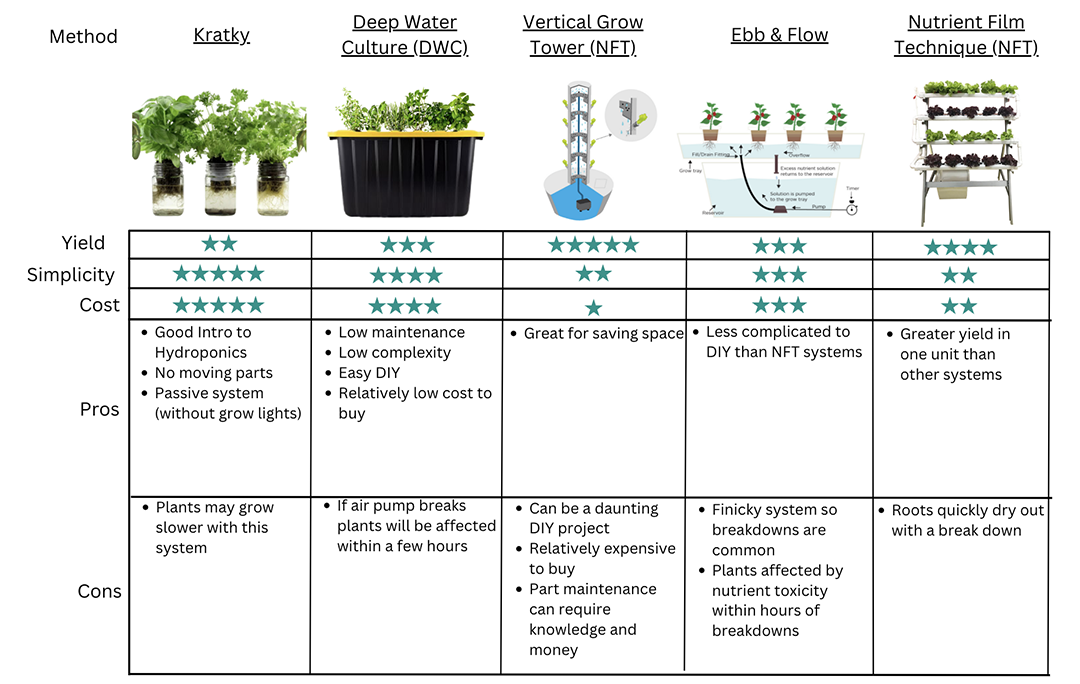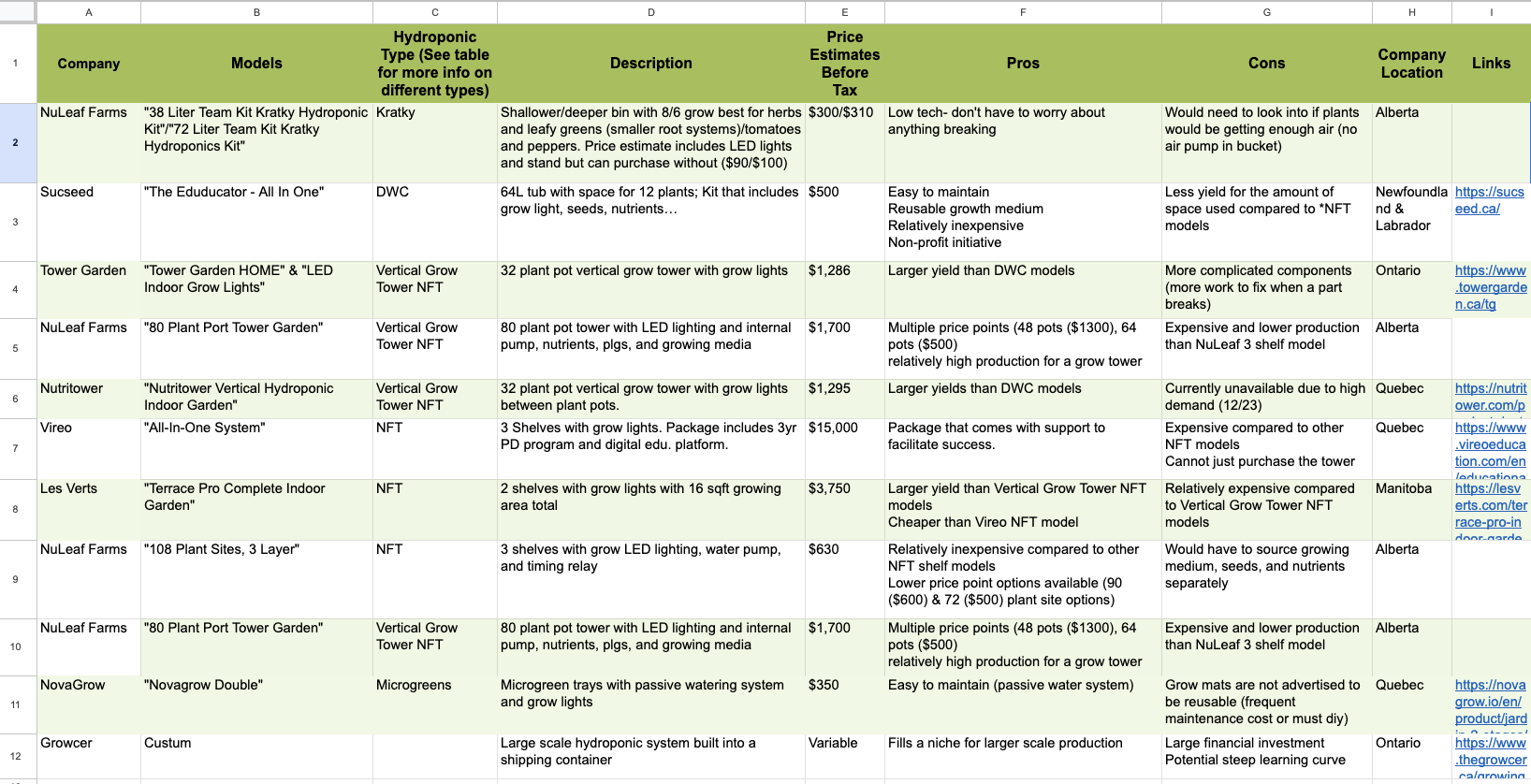This Resource Includes:
- Context
- Overview chart of types of hydroponics
- Link to the Working Hydroponics Models Comparison Resource Google Sheets document
1. Context
This resource was created to address the challenge of navigating through company websites to identify suitable hydroponic models for a school setting. What is suitable for one school, may not work for another. We recommend first identifying your school’s goals when it comes to introducing hydroponics and then exploring the many options available. We understand the complexity of this task and want to share our own progress in comparing various Canadian hydroponics companies. However, we present it as a draft because we acknowledge that there are models and companies that have not been included. Like the technology of hydroponics itself, our own learning and awareness continue to evolve.
Our intention is for this resource to serve as a starting point for your own research. If you choose to copy the Google Sheets file (linked below) and make additions, we encourage you to share your insights with us to enhance the resource. Please feel free to highlight or indicate your changes in the document and email it to grants@farmtocafeteriacanada.ca. Your contributions will help improve the comprehensiveness and accuracy of this resource.
As you use this resource, please keep in mind:
- Key factors to check that are not explored in this resource:
-
- Safe Plastics: Cheaper models, like many available from Amazon or other third-party retailers, can look similar but use cheaper/unsafe materials such as non-food-safe plastics.
- LED lights:
- LED lights are not created equally. Some can be weaker and not provide your plants with enough energy to grow and flourish as a company’s ads might suggest.
- Check with your school or school district facilities department about lightbulb compliance. Some may not be supported for safety or technical reasons.
- Replacement parts: Check the ease of finding replacement parts for if/when a part breaks. Difficult-to-replace parts could mean the whole unit gets put in a closet if a little part breaks.
- This is important to keep in mind if purchasing a cheaper model. Although it may be cheaper upfront, parts may break more quickly and may be difficult to replace. If you have a limited budget, consider going with a simpler system that is inherently cheaper, or if you have the capacity you could go the DIY route with higher-quality materials.
- Energy usage: Some systems can require a lot of power.
- Estimate the extra cost of power.
- Especially for old buildings, check whether your building’s electrical system can handle the power draw.
- Companies included:
- This list is not comprehensive and is meant to be a starting point for your research.
- We do not endorse any of the companies specifically but have contacted a few to get more details on products for this resource (NuLeaf Farms, Les Verts, Vireo) which could introduce some bias.
- Companies’ locations are included as ordering more locally may reduce shipping costs and/or you may wish to support a company closer to your school. This does not mean that all parts for these systems are sourced in these locations.
- Prices are estimates (last checked 12/23) and are not guarunteed.
- Something to be aware of with all systems that rely on a water/air pump is that if power is cut or the system malfunctions/breaks plants will dry out/drown within a few hours.
2.Types of Hydroponics Chart
As we began the research for this resource, it quickly became apparent that there’s a variety of hydroponic systems out there. Trying to compare them without understanding these different types is like trying to compare apples and oranges.
This chart serves as a handy tool to grasp the strengths and weaknesses of various hydroponic system types. Its aim is to assist you in streamlining your hydroponic search before delving into the multitude of available models.
It’s worth noting that this chart isn’t exhaustive, and our star rating system is intentionally simplified.
- More stars for Yield indicate a higher potential harvest per hydroponic system.
- In terms of Simplicity, higher-rated systems suggest fewer components that could malfunction, requiring less expertise or additional funds for replacements. Simpler systems also earn higher ratings for their user-friendliness, particularly as new teachers come in to take over the hydroponics initiative.
- Lastly, hydroponic systems with more stars in the Cost category generally tend to be more budget-friendly compared to those with fewer stars. However, actual costs may vary depending on the company and other factors to consider.
For more information about these systems, check out the links in the chart titles. Please note that the Kratky method is on the same page as the Deep Water Culture webpage.

3. The Working Hydroponics Models Comparison Resource Google Sheets document
Shown is a preview of the resource that is linked. This is a view-only Google doc. Feel free to make a copy so that you can add other companies, notes for the key factors mentioned above, or anything else that is helpful for you.





